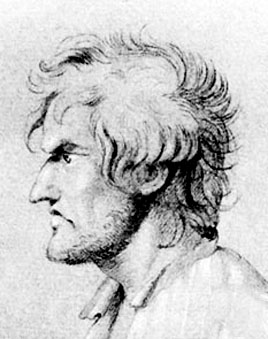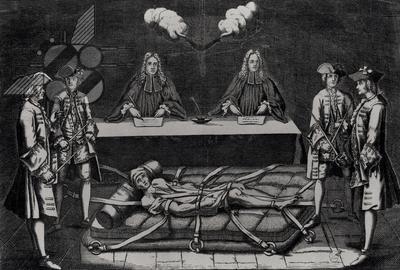Foucault, Michel. 1995. Discipline and Punish: The Birth of the Prison. New York: Vintage.
“‘Discipline’ may be identified neither with an institution nor with an apparatus; it is a type of power, a modality for its exercise, comprising a whole set of instruments, techniques, procedures, levels of application, targets; it’s a ‘physics’ or an ‘anatomy’ of power, a technology” (215). This technology of power identified by Foucault swarms from its points of applications (army, prison, school, etc) to become “deinstitutionalized” and begin to proliferate throughout the social body (211): “Not because the disciplinary mode of power has replaced all the others; but because it has infiltrated the others” (216).
Foucault explains, “this power is not exercised simply as an obligation or a prohibition on those who ‘do not have it’; it invests them, is transmitted by them and through them” (emphasis added, 27). Foucault shows how the conduction of peoples’ behavior implied a series of interventions—socially, bodily. Despite beginning with bodily torture, it seems the trajectory of discipline is toward interventions of escalating intimacy—e.g. the mind and the soul. (Interestingly, I just realized that “intimacy” and “intimidation” share the same etymological root: intimare, which comes closest to our verb intimate, meaning “to make known.” I’ll come back to this.)
Discipline’s intimacy of intervention comes through forcefully in Foucault’s quote of J. Servan—whoever s/he is—in which we see the stirrings of governmentality: “A stupid despot may constrain his slaves with iron chains; but a true politician binds them even more strongly by the chain of their own ideas… on the soft fibers of the brain is founded the unshakable base of the soundest of Empires” (103). In this way, discipline produces the individual and conditions their behavior and body; in aggregate, this is how populations are managed (170, 194). In institutions of governance and the state, this process takes on scientific precision. For instance, with the penitentiary system and the production of “delinquents,” punishment is “able to function openly as treatment and the sentence … inscribed among the discourses of knowledge” (256). Power is self-conscious.
The effective circulation of power turns, as much as possible, on its economy (applied only as much as needed) and the erasure of its operation. In illustrating this, Foucault presents the panopticon as the ideal exercise—a laboratory—of power: intense, efficient, omnipresent, ambiguous. Its physical success based on “the principle that power should be visible but unverifiable” (201). Punitive apparatuses pioneered and perfected discipline, but it became embedded in and permeated society through all kinds of state and non-state institutions with diverse sets of rationales.
In spite of the incessant popular attention to the panopticon, on aspect of the book I found fascinating is his treatment of the creation and shifts around illegality. I was actually struck upon this re-reading with how much he discusses legality/illegality in the book. For instance, citing narcotrafficking as one example, Foucault introduces a “useful delinquency,” explaining how “the existence of a legal prohibition creates around it a field of illegal practices, which one manages to supervise, while extracting from it an illicit profit through elements, themselves illegal, but rendered manipulable by their organization in delinquency” (280). Citing Marx’s 18th Brumaire, he also mentions the emergence of illegal/clandestine para-statal security forces in the same section. He says the growth of “great national or international illegalities directly linked to the political and economic apparatuses”—e.g. narcotrafficking—make clear that “delinquency is proving ineffective” (312).
This harks back to his earlier comment about delinquency and penal systems are conceived “as mechanism to administer illegalities differently, not to eliminate them all” (89). In the chapter on Generalized Punishment Foucault has a lot to say about the emergence of a prison-industrial-commercial complex around shifting implications of illegalities. The reform of punishment occurred at a time when in the Ancien Régime “illegality was so deeply rooted and so necessary for the life of each social stratum, that it had in a sense its own coherence and economy” (82).
He also traces—in an EP Thomspon way—how crime became inflected and judged as crimes associated with particular class positions (vagabondage, petty theft, wood collection, tax evasion, rebellion). For the most impoverished he explains, “The illegality of rights, which often meant the survival of the most deprived, tended, with the new status of property, to become an illegality of property. It then had to be punished” (85). Crimes against property became one source of the proliferation of illegality and, thus, crime, especially since it was link to material deprivation.
“The economy of illegalities was restructured with the development of capitalist society. The illegality of property was separated from the illegality of rights. This distinction represents a class opposition because, on the one hand, the illegality that was to be most accessible to the lower classes was that of property —the violent transfer of ownership—and because, on the other, the bourgeoisie was to reserve to itself the illegality of rights: the possibility of getting around its own regulations and its own laws, of ensuring for itself an immense sector of economic circulation by a skillful manipulation of gaps in the law—gaps that were foreseen by its silences, or opened up by de facto tolerance” (87).
With the growth of capitalism and population the “equilibrium of tolerance, mutual support and interests which, under the Ancien Régime, had maintained illegalities of different social strata side by side was disturbed” (272). But a new danger of popular illegality emerged and some of these began taking on political dimensions (refusal to pay taxes, draft evasion, looting, workers’ strikes, and ultimately revolution/rebellion). Some of these political expression became turned against the law itself, rather than against financiers, tax exactors, judges, etc. “It was against a new régime of landed property—set up by a bourgeoisie that profited from the Revolution—that a whole peasant illegality developed” (274). The fusion of this new ensemble of illegality was perceived as particularly threatening.
“But, in their emerging form and despite their dispersal, they were sufficiently marked to serve as a support for the ‘great fear’ of a people who were believed to be criminal and seditious as a whole, for the myth of a barbaric, immoral and outlaw class which … haunted the discourse of legislators, philanthropists and investigators into working-class life” (275). The “failure” of the prisons—failure understood as in Ferguson’s Anti-Politics Machine—works through this differential treatment of illegality. “Delinquency” is what underwrites and makes possible for the penal apparatus to “differentiate, accommodate and supervise illegalities” (277). “Delinquency, controlled illegality, is an agent for the illegality of dominant groups” (279). “It may be, therefore, that crime constitutes a political instrument” (289). And in relation to technologies of power: “Replacing the adversary of the sovereign, the social enemy was transformed into a deviant, who brought with him the multiple danger of disorder, crime and madness” (299-300).



Pingback: Hollow Land and the Politics of Archupation | Territorial Masquerades
Pingback: Marx: Debates on Law on Thefts of Wood | Territorial Masquerades
Pingback: Albion's Fatal Tree | Territorial Masquerades
Pingback: Craib: Cartographic Mexico | Territorial Masquerades